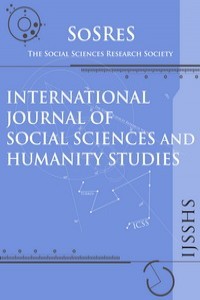TWO STRATEGIC SUCCESS FACTORS FOR FIRM LEVEL COMPETITIVENESS: INNOVATION AND COOPERATION
TWO STRATEGIC SUCCESS FACTORS FOR FIRM LEVEL COMPETITIVENESS: INNOVATION AND COOPERATION
Competitiveness, Innovation, Cooperation,
___
- Ambastha, A.,Momaya, K. (2005), Competitiveness of Firms: Review of Theory,
- Frameworks and Models, Singapore Management Review, Vol.26, N.1, p.45–61
- Solow R.M. (1957), Technical Progress and The Aggregate Production Function, Review of Economics and Statistics, Vol.39, pp.312-320
- Barney J.B.(1991), Firm Resources and Sustained Competitive Advantage. Journal of Management, Vol.17, N.1, pp.99-120
- Bellak, C. J. & Weiss, A.(1993), A Note On the Austrian,Diamond, Management International Review, Vol.33, pp.109-118
- Bosch, F. A. J., Prooijen, A. (1992). The Competitive Advantage of European Nations: The Impact of National Culture – a Missing Element in Porter’s Analysis?, European Management Journal, Vol.10, N.2, pp.173–177
- Cibinskiene A.(2010), Relation of Infrastructure Natural Monopolies and National Competitiveness, Economics And Management, Vol.15, N.1, pp.62-69
- Clark J., Guy K.(1998), Innovation and Competitiveness: A Review, Technology Analysis & Strategic Management, Vol.10, N.3, pp.363-395
- Cho, D. S.; Moon, H. C.(2000). From Adam Smith to Michael Porter: Evolution of Competitiveness Theory. Korea, Asia-Pacific Business Series, p.223
- Dosi G. (1988), Sources, Procedures, and Microeconomic Effects of Innovation, Journal of Economic Literature, Vol.36, pp.1126-1171
- Dunning, J. H. (1993), Internationalizing Porter’s Diamond, Management International Review, Vol.33, pp.7-15
- Fagerberg J. (1987), A Technology Gap Approach to Why Growth Rates Differ, Research Policy, Vol.16, pp.87-107
- Littlejohn S.(1986), Competition and Cooperation: New Trends in Corporate Public Issue Identification and Resolution, California Management Review, Vol.24, N.1, p.110-128
- Krugman, P. (1994), Competitiveness: A Dangerous Obsession, Foreign Affairs,Vol.73, N.2, pp.28–44
- Moon, H. C.; Rugman, A. M.; Verbeke, A. (1998), A Generalized Double Diamond Approach to the Global Competitiveness of Korea and Singapore, International Business Review, Vol.7, N.2, pp.135–150
- Narula, R.(1993), Technology, International Business and Porter’s “Diamond”: Synthesizing a Dynamic Competitive Development Model, Management International Review, Vol.33, pp.85-107
- Osarenkhoe A.(2010), A Study of Inter-Firm Dynamics Between Competition and Cooperation – A Coopetition Strategy, Database Marketing & Customer Strategy Management, Vol.17, N.3, pp.201-221
- Padula G., Dagnino G.B.(2007), Untangling the Rise of Coopetition: The Intrusion of Competition in a Cooperative Game Structure, International Studies of Management & Organization, Vol.27, N.2, pp.32-52
- Peteraf M.A., Barney J.B.(2003), Unravelling the Resource-Based Tangle. Managerial and Decision Economics, Vol.24, pp.309-323
- Porter M.E.(1990), The Competitive Advantage of Nations, New York: Free Press Powell W., Koput, K., Smith-Doerr L.(1996), Inter-Organizational Collaboration and the Locus of Innovation: Networks of Learning in Biotechnology, Administrative Science Quarterly, Vol. 41, N.1, pp.116–145
- Rugman A. M. & D’Cruz, J. R.(1993), The Double Diamond Model of International
- International Review, Vol.33, pp.17-39 The Canadian Experience,
- Management Schermerhorn J.(1975), Determinants of Inter-Organizational Cooperation, Academy of Management Journal, Vol.18, N.4, pp.846-855
- Başlangıç: 2009
- Yayıncı: Sosyal Bilimler Araştırmaları Derneği
THE LEGAL CHARACTERS OF THE SALES CONTRACT
Sorin FİLDAN, Narcisa Mihaela STOİCU
THE IMPACTS OF SELF-BRAND CONGRUENCE ON BRAND LOYALTY: A STUDY ON CELLULAR PHONE USERS
Can Deniz Köksal, Mehmet Özer Demir
WEIGHT SYSTEMS IN A CPI ANALYSIS
Saving Investment Correlations and Capital Mobility: Evidence from Transition Economies
HEURISTIC MODEL OF TAXPAYER BEHAVIOUR: THEORY AND METHODOLOGY
LEADERSHIP AND PROFESSIONALISM AS FUTURE CHALLENGE IN PUBLIC SECTOR UNIVERSITY MANAGEMENT
Dita STEFENHAGENA, Voldemars BARİSS
Siti Aisyah Binti PANATİK, Nurul Farhana Bt Mohd NOORDİN, Roziana SHAARİ, Siti Khadijah Zainal BADRİ
Melissa QUETULİO-NAVARRA, Anke NİEHOF, Wander Van Der VAART, Hilje Van Der HORST, Suliyanto Se MM
BANKING SECTOR, STOCK MARKET AND ECONOMIC GROWTH: EVIDENCE FROM MENA COUNTRIES
